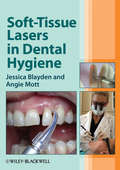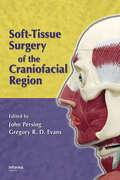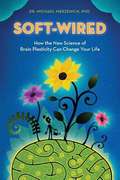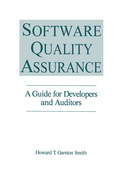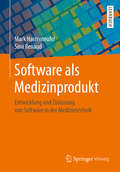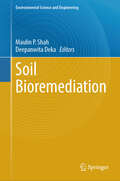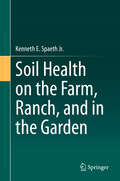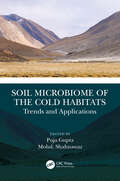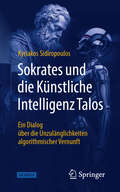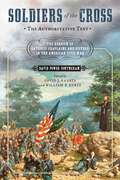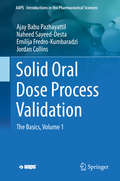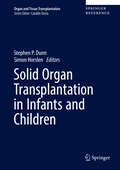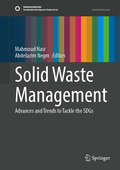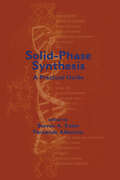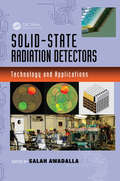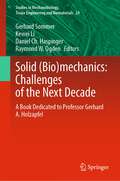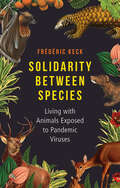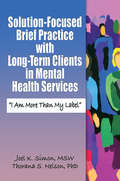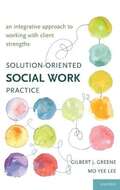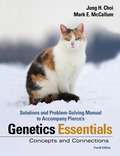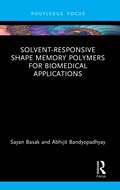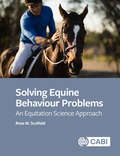- Table View
- List View
Soft-Tissue Lasers in Dental Hygiene
by Jessica Blayden Angie MottThe uses and benefits of soft-tissue lasers in dental hygiene practice are myriad. Lasers are used for more effective debridement, scaling and planning, with less pain and bleeding. Hygienists can detect sub- and supra-gingival calculus, remove the bacteria in pockets, and remove granulation, among other treatments.Soft-tissue Lasers in Dental Hygiene is the first book to explain laser use in periodontal therapy. Authors Jessica Blayden and Angie Mott are registered dental hygienists who have been using laser therapy in their dental hygiene practices for several years, and here they share their experience. Blayden and Mott begin by discussing laser history, physics, components, and safety. They then describe the specifics of periodontal therapy--what lasers can be used for, how to implement them, techniques, and protocols. The authors also present case studies that demonstrate how treatment plans are implemented for varying levels of periodontal disease. The authors conclude with chapters on patient communication and practice management.
Soft-Tissue Surgery of the Craniofacial Region
by Gregory R. D. Evans John A. PersingWhether from trauma, congenital deformity, or disease, many patients can present with disfiguring and debilitating facial defects. This reference presents a range of expertise on soft-tissue surgery of the craniofacial region for improved function and enhanced cosmetic appearance. Covering the latest technologies available, this source includes cha
Soft-Wired: How the New Science of Brain Plasticity Can Change Your Life
by Michael MerzenichWhat if you had the power to change your brain for the better? In Soft-Wired, Dr. Michael Merzenich--a world authority on brain plasticity--explains how the brain rewires itself across the lifespan, and how you can take control of that process to improve your life. In addition to fascinating descriptions of how your brain has produced your unique memories, skills, quirks, and emotions, Soft-Wired offers sound advice for evaluating your brain and gives clear, specific, scientifically proven guidance for how to rejuvenate, remodel, and reshape your brain to improve it at any age.
Software Quality Assurance: A Guide for Developers and Auditors
by Howard T. SmithOf all the audit functions faced by QA, software auditing is probably the most difficult because of the need to know and understand the intricacies of the processes being audited. In addition, auditors must be familiar with and understand the implications of the international and national standards and know how to proceed when deficiencies are revealed. Howard Garston Smith is Software Quality Assurance Auditor for Pfizer, UK, and brings twenty years of expertise in software development and auditing to this incredibly detailed manual. He provides the "what to" and the "how to" of software QA auditing in a clear and practical style that guarantees effective software quality audits.
Software als Medizinprodukt: Entwicklung und Zulassung von Software in der Medizintechnik
by Mark Hastenteufel Sina RenaudLernen Sie mit diesem Buch, wie Sie Software erfolgreich als Medizinprodukt entwickeln und zulassenDie zunehmende Digitalisierung bringt enorme Fortschritte in der Medizin. Softwarelösungen sind längst ein integraler Bestandteil moderner Medizintechnik. Gleichzeitig verschärft sich die Gesetzgebung für die Entwicklung medizinischer Software zunehmend. Viele Software-Hersteller stehen deshalb vor der Herausforderung, die schnellen Entwicklungen mit der langsameren Bürokratie rund um Gesetzesänderungen in Einklang zu bringen. Dieses Buch zeigt Ihnen alles, was Sie über die Entwicklung von Software als Medizinprodukt wissen müssen. Die Autoren erläutern die wichtigen Aspekte entlang des Software-Lebenszyklus und helfen Medizintechnikern bei der Formulierung von Softwareanforderungen für Medizinprodukte. Auch die oft Hardware-lastig formulierten Medizintechnik-Normen erklären die Autoren auf leicht verständliche Weise. Das Buch schlägt eine Brücke zwischen Medizintechnik und IT-Industrie. Neben europäischen Regularien berücksichtigen Mark Hastenteufel und Sina Renaud auch internationale Aspekte. Einblicke in die Branche und Praxis Die Autoren geben Ihnen in diesem Buch zunächst einen kurzen Überblick über die wirtschaftliche Bedeutung von Software als Medizinprodukt. Sie klären, warum Medizintechnik ein bedeutender Wirtschaftsfaktor ist und zeigen, was die Branche besonders macht. Anschließend setzen sie sich mit diesen Kernthemen auseinander:· Die Grundlage: Medical Device Regulation (MDR)· Die Umsetzung: Normen, Spezifikationen und Guidelines· Grundlagen des Software Engineerings· Software als Medizinprodukt· Zulassungen in den USA· Ausblick auf weltweite Zulassungen Damit hilft dieses Buch Medizintechnikern, ihr Wissen über die Digitalisierung auszubauen. Software-Entwicklern erleichtert es den Weg in die Medizintechnik. Eine Empfehlung, wenn Sie mit den Grundlagen vertraut sind Leser sollten für das Buch „Software als Medizinprodukt“ bereits ein gewisses Grundverständnis im Bereich IT und Softwareentwicklung mitbringen, besonders in Hinblick auf Programmierung und Modellierung. Daher ist dieses Werk auf folgende Zielgruppen ausgerichtet:a) Dozierende und Studierende der Fachgebiete Software-Engineering, Medizininformatik und -technikb) Praktiker wie Softwareentwickler, -Projektleiter oder Qualitätsmanager bei Medizintechnikherstellern
Soil Bioremediation (Environmental Science and Engineering)
by Maulin P. Shah Deepanwita DekaThis book is presented on bioremediation of soil including different aspects for sustainable development of agriculture, environment etc. Significant attention is being paid to plants and microbes because of their metabolomics, molecular mechanisms, biochemical pathways, bioengineering, and cost-effective nature in an eco-friendly green approach. It presents a detailed account on phytoremediation, microbial remediation; application of different plants and microorganisms for bioremediation in agricultural soil; nanoparticles, metabolites produced by plants and microbes for bioremediation of soil; multidisciplinary approaches of bioremediation to alleviate major soil contamination issues, molecular mechanisms, biochemical approach of bioremediation of soil; plants and microbial engineering for bioremediation; recent advances and challenges; future prospects of bioremediation of contaminated soil, utilizing biodiversity for sustainable development of the soil ecosystem.
Soil Health on the Farm, Ranch, and in the Garden
by Kenneth E. Spaeth Jr.This book explores the importance of soil health in croplands, rangelands, pasturelands, and gardens, and presents new methods and technologies for assessing soil dynamics and health in these different land types. Through perspectives of agriculture, soil management, and ecological sustainability, the book provides accurate and up-to-date information on soil health assessment and maintenance that is often missing from current literature on conservation and environmental management and preservation. The book is written in a clear and concise format, and will appeal to non-scientists interested in soil health, as well as professional farmers, ranchers and gardeners. The book begins by discussing soil health from a historical perspective, and in terms of how it is covered in the news currently. Then the author addresses the ecological implications of soil health in farming, ranching and gardening, and comprehensively details the physical, chemical and biological properties of soil as they apply in various land types. The book then examines soil health assessment using new diagnostic and analytic technologies, and how these new innovations will be necessary going forward to maintain and improve soil health.
Soil Microbiome of the Cold Habitats: Trends and Applications
by Puja Gupta and Mohd. ShahnawazThis book focuses on cold habitat microbes as a potential source of elite enzymes and secondary metabolites to meet the growing demands of the pharmaceutical, food and biotechnological industries. Microbes living in such extremely cold conditions are reported to produce various biomolecules with potential biotechnological applications. The book overviews recent research trends to discover such important biomolecules and also suggests future research directions to discover such elite novel biomolecules. Salient features: Covers studies on various biotic communities and abiotic components of the soil of terrestrial habitats with a focus on cold habitats Discusses various 'Omic' approaches: metagenomics and meta-transcriptomics Lists adaptation strategies adopted by cold-adapted microbes Highlights various biotechnological and industrially important biomolecules produced by cold-adapted microbes Explores the role of microbial biofilm in the degradation of microplastics in cold habitats
Sokrates und die Künstliche Intelligenz Talos: Ein Dialog über die Unzulänglichkeiten algorithmischer Vernunft
by Kyriakos SidiropoulosDas Sachbuch stellt die Debatte über künstliche Intelligenz in einen philosophischen Rahmen und nutzt dabei den Dialog als narrative Form. Im heutigen Athen stellen Sokrates und seine Schüler Platon und Aristoteles einem fiktiven KI-System namens Talos eine Reihe von Fragen, die die Grenzen des menschlichen und maschinellen Denkens ausloten. Der Dialog lädt zur Reflexion über grundlegende Themen wie die Natur des Wissens, des Bewusstseins, der Ethik und der menschlichen und maschinellen Autonomie ein. Das Buch bietet nicht nur Einblicke in die Chancen und Herausforderungen intelligenter Maschinen, sondern regt auch zur kritischen Diskussion über die ethischen und praktischen Konsequenzen ihrer Entwicklung an. Ein inspirierender Beitrag für alle, die philosophische und gesellschaftliche Fragen der künstlichen Intelligenz besser verstehen und mitdiskutieren möchten.
Soldiers of the Cross, the Authoritative Text: The Heroism of Catholic Chaplains and Sisters in the American Civil War
by David Power Conyngham&“Students of the Civil War, Catholic history, and women&’s history, among others, will welcome [Soldiers of the Cross] . . . Brilliantly edited.&” —Randall M. Miller, co-editor of Religion and the American Civil War Shortly after the Civil War, an Irish Catholic journalist and war veteran named David Power Conyngham began compiling the stories of Catholic chaplains and nuns who served during the conflict. His manuscript, Soldiers of the Cross, is the fullest record written during the nineteenth century of the Catholic Church&’s involvement in the Civil War, as it documents the service of fourteen chaplains and six female religious communities, representing both North and South. Many of Conyngham&’s chapters contain new insights into the clergy during the war that are unavailable elsewhere, either during his time or ours, making the work invaluable to Catholic and Civil War historians. The introduction contains over a dozen letters written between 1868 and 1870 from high-ranking Confederate and Union officials, such as Confederate General Robert E. Lee, Union Surgeon General William Hammond, and Union General George B. McClellan, who praise the church&’s services during the war. Chapters on Fathers William Corby and Peter P. Cooney, as well as the Sisters of the Holy Cross, cover subjects relatively well known to Catholic scholars, yet other chapters are based on personal letters and other important primary sources that have not been published prior to this book. Due to Conyngham&’s untimely death, Soldiers of the Cross remained unpublished, hidden away in an archive for more than a century. Now annotated and edited so as to be readable and useful to scholars and modern readers, this long-awaited publication of Soldiers of the Cross is a fitting presentation of Conyngham&’s last great work
Solid Oral Dose Process Validation, Volume Two: Lifecycle Approach Application (AAPS Introductions in the Pharmaceutical Sciences)
by Naheed Sayeed-Desta Emilija Fredro-Kumbaradzi Jordan Collins Ajay Pazhayattil Marzena IngramThe textbook addresses the lifecycle concepts (Stage 1, 2, 3) of Process Validation. Regulatory bodies such as US FDA, EMEA, WHO, PIC/S have adopted the ICH lifecycle approach. Organizations have an opportunity to harmonize and align PV activities for all regulated markets. The concepts discussed provides a direction on how to approach solid dose manufacturing process validation for regulatory compliance. Solid Oral Dose Process Validation, Lifecycle Approach: Application, Volume Two and the companion Volume One, Solid Dose Process Validation, The Basics, also available as a set, provide directions and solutions for the pharmaceutical industry. The topics and chapters give a systematic understanding for the application of lifecycle concepts in solid dose pharmaceutical manufacturing. Since solid dose formulations encompass majority of the pharmaceutical preparations, it is essential information for pharmaceutical professionals who use the process validation lifecycle approach. This set is published as a comprehensive solution for solid dose process validation.
Solid Oral Dose Process Validation: The Basics, Volume 1 (AAPS Introductions in the Pharmaceutical Sciences)
by Ajay Babu Pazhayattil Naheed Sayeed-Desta Emilija Fredro-Kumbaradzi Jordan CollinsCurrently there are no process validation (PV) textbooks addressing the lifecycle concepts (Stage 1, 2, 3). Recent regulatory guidance's such as US FDA, EMEA, WHO, PIC/S have adopted the ICH lifecycle approach. The concepts are now harmonized across regulatory guidance's and organizations have an opportunity to align PV activities for all regulated markets. Therefore a need exists for consensus and direction on how to approach solid dose manufacturing process validation for regulatory compliance. Solid Dose Process Validation: The Basics, Volume One and companion Solid Dose Process Validation: Lifecycle Approach Application, Volume Two, also available as a set, provide directions and solutions for these unmet needs for the pharmaceutical industry. The topics and chapters give a systematic understanding for the application of lifecycle concepts in solid dose pharmaceutical manufacturing. All approaches meet the regulatory requirements enlisted in the guidance’s, which is the precursor to applying the concepts. This set is published as a comprehensive solution for solid dose process validation. Since solid dose formulations encompass majority of the pharmaceutical preparations, it is essential information for pharmaceutical professionals who use the process validation lifecycle approach.
Solid Organ Transplantation in Infants and Children (Organ And Tissue Transplantation Ser.)
by Stephen P. Dunn Simon HorslenA new textbook of transplantation for infants and children is needed that is at least a first effort at achieving standard work in this field. Solid Organ Transplantation in Infants and Children provides a broad view of the current practice of solid organ transplantation in pediatric patients. It focuses on best practice and measureable outcomes whenever possible. It provides direct guidance for standard work in this broad and young field of clinical work. It portrays the regulatory environment in which this work occurs and the specific program requirements for each clinical program. Organized in two volumes, the first volume is devoted to the pediatric patient and their particular needs or concerns. This volume also contains information on the regulatory environment and pediatric program specific requirements. The second volume is devoted to the standard work in each solid organ transplanted. These volumes will be very useful for every practicing pediatric transplant program in the United States and Canada and much of the developed world. By reading these volumes, the reader will gain a firm understanding and practical knowledge of standard work in solid organ transplantation and the regulatory environment and requirements of programs to do that work.
Solid Waste Management: Advances and Trends to Tackle the SDGs (Sustainable Development Goals Series)
by Abdelazim Negm Mahmoud NasrThis book covers the latest advances in sustainable waste management and focuses on its implementation to mitigate water and air pollution, recycle and reuse raw material, and refine valuable metals. In this book, readers will learn about organic waste treatment, emerging waste management techniques, and the transformation of waste into value-added products. Particular attention is given to environmental sustainability and how we can better achieve it through innovative and responsible waste management practices. Divided into 10 chapters, the book outlines a wide range of topics such as the sustainable management of food wastes through cavitation-assisted conversion, rapid bioconversion of animal meat waste into compost using black soldier fly larvae, thermoluminescence properties of combustion-synthesized nanomaterials and their applications for achieving Sustainable Development Goals, and the creative reuse of plastic waste with a case study by Ghanaian artists. Expert contributors uncover new methods and approaches to waste management that invite readers to think critically about the current practices and their impact on the environment. In addition to these discussions, the work explores the challenges of environmental health in waste management for peri-urban areas. This book provides a unique blend of theoretical perspectives and practical case studies that will enrich the understanding of sustainable waste management, and it equips readers with the knowledge needed to contribute to a more sustainable future. The book is an invaluable resource for researchers in the field of environmental science, students at all levels studying sustainability and waste management, and practitioners working in industry.
Solid-Phase Synthesis: A Practical Guide
by Steven A. Kates Fernando AlbericioThis volume provides the information needed to synthesize peptides by solid-phase synthesis (SPS) - employing polymeric support (resins), anchoring linkages (handles), coupling reagents (activators), and protection schemes. It presents strategies for creating a wide variety of compounds for drug discovery and analyzes peptides, DNA, carbohydrates,
Solid-State Radiation Detectors: Technology and Applications (Devices, Circuits, and Systems #41)
by SALAH AWADALLA AND KRZYSZTOF INIEWSKIIntegrating aspects of engineering, application physics, and medical science, Solid-State Radiation Detectors: Technology and Applications offers a comprehensive review of new and emerging solid-state materials-based technologies for radiation detection. Each chapter is structured to address the current advantages and challenges of each material and technology presented, as well as to discuss novel research and applications. Featuring contributions from leading experts in industry and academia, this authoritative text:Covers modern semiconductors used for radiation monitoringExamines CdZnTe and CdTe technology for imaging applications including three-dimensional capability detectorsHighlights interconnect technology for current pixel detectorsDescribes hybrid pixel detectors and their characterizationsTackles the integrated analog signal processing read-out front ends for particle detectorsConsiders new organic materials with direct bandgap for direct energy detectionSummarizes recent developments involving lanthanum halide and cerium bromide scintillatorsAnalyzes the potential of recent progress in the field of crystallogenesis, quantum dots, and photonics crystals toward a new concept of x- and gamma-ray detectors based on metamaterialsExplores position-sensitivity photomultipliers and silicon photomultipliers for scintillation crystalsSolid-State Radiation Detectors: Technology and Applications provides a valuable reference for engineers and scientists looking to enhance the performance of radiation detector technology for medical imaging and other applications.
Solid: A Book Dedicated to Professor Gerhard A. Holzapfel (Studies in Mechanobiology, Tissue Engineering and Biomaterials #24)
by Raymond W. Ogden Gerhard Sommer Kewei Li Daniel Ch. HaspingerThis book offers a comprehensive and timely overview of the latest developments in the field of biomechanics and extensive knowledge of tissue structure, function, and modeling. Gathering chapters written by authoritative scientists, it reports on a range of continuum and computational models of solids, and related experimental works, for biomechanical applications. It discusses cutting-edge advances such as constitutive modeling and computational simulation of biological tissues and organs under physiological and pathological conditions, and their mechanical characterization. It covers innovative studies on arteries, heart, valvular tissue, and thrombus, brain tumor, muscle, liver, kidney, and stomach, among others. Written in honor of Professor Gerhard A. Holzapfel, the book provides specialized readers with a thorough and timely overview of different types of modeling in biomechanics, and current knowledge about biological structures and function.
Solidarity Between Species: Living with Animals Exposed to Pandemic Viruses
by Frederic KeckThis book examines how the Covid-19 pandemic can be described as a biopolitical crisis, taking into account a fact often overlooked by commentators: Covid-19 is a zoonosis, a disease transmissible between animal species. The Sars-Cov2 virus causing this respiratory disease circulated in bats before passing to humans under as-yet mysterious conditions, and it was transmitted from humans to other species, notably mink and deer. Building on Michel Foucault’s revival of the term “biopolitics” and related notions (disciplinary power, pastoral power, cynegetic power), this book traces a set of public health measures taken over the last two centuries to control epidemics. It underlines how the need to conserve virus strains in order to identify and anticipate their mutations has given rise to cryopolitics, a set of techniques aimed at suspending the living in order to defer death. The book then questions the emancipatory scope of this cryopolitics by examining interspecies solidarity built by the warning signals sent by animals to humans about coming threats, be they pandemics, natural disasters, or climate change. By blurring the boundaries between the wild and the domestic resulting from the process of domestication, the politics of zoonoses relies on sentinels who preserve the memory of signs from the past to prepare living beings for future threats by involving them in a common ideal.
Solidarity in Biomedicine and Beyond
by Barbara Prainsack Alena BuyxIn times of global economic and political crises, the notion of solidarity is gaining new currency. This book argues that a solidarity-based perspective can help us to find new ways to address pressing problems. Exemplified by three case studies from the field of biomedicine: databases for health and disease research, personalised healthcare, and organ donation, it explores how solidarity can make a difference in how we frame problems, and in the policy solutions that we can offer.
Solution-Focused Brief Practice with Long-Term Clients in Mental Health Services: "I Am More Than My Label"
by Thorana S. Nelson Joel K. SimonValuable patient-centered ideas for treating mental illness <P><P> Traditional forms of mental health care can often center more on simply avoiding hospitalization than on promoting wellness by focusing on a patient’s personal feelings and hopes. In fact, these established methods can even have a dehumanizing and devaluing effect on a patient. Solution-Focused Brief Practice with Long-Term Clients in Mental Health Services is a practical introduction and guide that provides practitioners an alternative way of thinking about and working with individuals who have been long-term users of the mental health system. Through interviews, case studies, and actual client testimony, this valuable text demonstrates the most effective ways to establish patient-centered conversations that forge collaborative relationships, realize strengths, and use them to move toward healing. Solution-Focused Brief Practice with Long-Term Clients in Mental Health Services is a strength-based approach that utilizes a client’s personal and social resources to help them find a satisfactory solution to the sources of their need for professional help. This book offers a unique approach that can be applied to those who have been in the mental health system for many years and may remain so. Accessible and useable, this guide explores the meaning of conventional diagnosis and treatment and how both can actually reinforce the client’s disability, chronicity, and sense of helplessness as a person. Topics Solution-Focused Brief Practice with Long-Term Clients in Mental Health Services covers include: the tools of solution-focused brief practice working with borderline personality disorder adaptability and application to different contexts “reading” the client during discussion sessions emphasizing an individual’s healthy parts the role of community support rethinking the medical model implementing solution-focused practices in agencies and hospitals poststructuralism, social constructionism, and language games and many more! Solution-Focused Brief Practice with Long-Term Clients in Mental Health Services is extensively referenced with a detailed bibliography. It is an essential resource for psychiatrists, social workers, psychologists, family therapists, counselors, nurse practitioners, and schools of social work and family therapy training programs. Staff of inpatient psychiatric hospitals, psycho-social clubs, and community mental health clinics will also benefit from this indispensable text.
Solution-Focused Interviewing
by Ronald E. WarnerToo often doctors, therapists, and social workers ask "what's wrong in your life?" rather than "what do you want?" Ronald E. Warner's Solution-Focused Interviewing is a practical guide to talking to clients using a solution-driven and strength-based approach that empowers clients and helps them to find lasting solutions to their problems.In Solution-Focused Interviewing, asking questions about clients' goals and resources - the strengths that will let them change their lives - is the basis of a three-phase therapeutic process that builds empathy before helping clients to set realistic goals and build a plan to achieve them.Based on more than two decades of solution-focused therapy workshops and Warner's extensive clinical experience, Solution-Focused Interviewing is the first skill development manual based on this innovative tri-phase approach to interviewing.
Solution-oriented Social Work Practice: An Integrative Approach To Working With Client Strengths
by Mo Yee Lee Gilbert J. GreeneToo often in practice, there is a tendency to pathologize clients, requiring a diagnosis as part of the helping relationship. Suppose, however, that most of the client problems that social workers encounter have more to do with the vagaries of life and not with what clients are doing wrong. This powerful idea is the philosophy behind the strengths-based approaches to social work. This groundbreaking practice handbook takes this concept one step further, combining the different strengths-based approaches into an overarching model of solution-oriented social work for greater impact. The strengths perspective emphasizes client strengths, goal-setting, and a shared definition of positive outcome. Solution-focused therapy approaches ongoing problems when they have temporarily abated, amplifying exceptions as solutions. This natural but rarely explored pairing is one component in the challenging and effective practice framework presented here by the authors, two seasoned practitioners with over 50 years of combined experience. By integrating the most useful aspects of the major approaches, a step-by-step plan for action emerges. With this text in hand, you will: - Integrate elements from the strengths perspective, solution-focused therapy, narrative therapy, and the strategic therapy of the Mental Research Institute (the MRI approach) into an effective and eclectic framework - Build and practice your skills using case examples, transcripts, and practical advice - Equip yourself with the tools you need to emphasize clients' strengths - Challenge the diagnosis-first medical model of behavioral health care - Collaborate with clients to get past thinking (first-order change), and more to acting "outside the box" (second-order change) - Learn to work with a wide variety of clients, including individuals, groups, and families; involuntary clients; clients with severe mental illness; and clients in crisis For any student or practitioner interested in working with clients towards collaborative and empowering change, this is the essential text.
Solutions and Problem-Solving Manual to Accompany Pierce’s Genetics Essentials: Concepts And Connections (Fourth Edition)
by Pierce Choi McCallumSolutions and Problem-Solving Manual to Accompany Pierce’s Genetics Essentials
Solvent-Responsive Shape Memory Polymers for Biomedical Applications
by Abhijit Bandyopadhyay Sayan BasakThis book explains the intricacies of one-way shape memory polymers (SMPs), with a particular emphasis on solvent-responsive SMPs focusing on fundamental pathways and key principles crucial to the development of these materials. The subsequent section homes in on the specific realm of solvent-responsive SMPs, highlighting the potential advantages these polymers offer and critical evaluation of existing shortcomings and research gaps. It further explains how solvent-responsive SMPs aim to address challenges and advancements within the biomedical industry.Features: Delve into the latest developments and research findings on solvent-responsive shape memory polymers. Explore practical and real-world applications of solvent-responsive shape memory polymers in the biomedical domain. Provide an understanding of these polymers from molecular to macroscopic levels. Explore the underlying physics, chemistry, and thermodynamics that govern the mechanism of solvent-driven shape change in these polymers. Review innovations in the design of solvent-responsive shape memory polymers and their applications across a variety of industrial fields. Examine how solvent-responsive shape memory polymers can be integrated and applied across different scientific disciplines. This book is aimed at graduate students and researchers in polymer engineering, materials science, and bioengineering.
Solving Equine Behaviour Problems: An Equitation Science Approach
by Rose M ScofieldHorses can develop a range of behavioural problems, which if left untreated, could cause the relationship between horse and human to break down. With many different well-meaning opinions offered to solve such situations, it can be difficult to find the right path. In this book, Rose Scofield examines behavioural issues using the latest academic research. Offering practical solutions and with useful diagrams and photographs throughout, the book helps to protect and develop the horse-human relationship. It: - Addresses issues by circumstance, making it easy to find solutions to all your handling, groundwork, and riding problems; - Uses scientific research to investigate both the problems themselves and the methods tasked to solve them; - Includes illuminating case studies illustrating problems and how solutions work in practice. Beginning with an introduction to the main principles of equitation science, Solving Equine Behaviour Problems then covers over 30 major issues, including biting, kicking, separation anxiety, loading, shying, bucking and bolting. It provides key points, take home messages and scientific references, translating lessons from experimental science into practical help for both professionals and the horse enthusiast.
